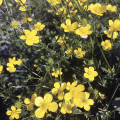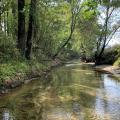Winter Drawdowns
Winter Drawdowns
Using Water Level Drawdowns
One of the most useful and inexpensive pond management practices is called a “winter drawdown.” Water levels are reduced in a pond to some predetermined level, generally exposing 35 to 50 percent of the pond-bottom area. Winter drawdowns can be useful in controlling aquatic weeds and can help manipulate fish populations. They are also useful when repairing, redesigning, and liming ponds.
To perform a winter drawdown, make sure the pond has a drain pipe that lets the water levels be lowered and kept down throughout the winter. Ponds without a drainpipe can be retrofitted.
Drawdown for Aquatic Weed Control
Aquatic weed problems are common in farm ponds and usually are challenging to manage. Of the four basic weed control methods (physical, mechanical, biological, and chemical), physical control can be the least expensive and most convenient if it consists of a winter drawdown. Winter drawdown exposes weeds to air-drying and freezing temperatures. This can be an effective weed control technique, especially if done in successive years.
For effective weed control, drop the water level of the pond to expose aquatic weeds in the shallower portions of the pond. Usually, water levels are reduced enough to expose 35 to 50 percent of the pond bottom, but this percentage may vary greatly, depending on topography and design of the pond. Maximum drawdown should be accomplished by mid- to late November, and the water level should remain low through February. Spring rains will refill the pond.
If necessary, deepen the shoreline to 3 feet deep while water levels are reduced. This reduces the likelihood of weeds returning. After reflooding, if weeds persist and begin to sprout, apply an appropriate herbicide. The combination of a winter drawdown, shoreline deepening, and effective early-spring herbicide application usually eliminates or greatly reduces aquatic weed infestations.
Drawdown for Fish Management
Winter drawdown is also a good fish population management technique in largemouth bass/bluegill ponds. By reducing the water level and pond area, you drive forage fish, such as bluegill, out of shallow water refuges and concentrate them in open water, making them more available for bass to eat. This is a good technique to use in ponds having “crowded bluegill” but still containing viable bass populations. The increased feeding by largemouth bass on bluegill reduces bluegill numbers and provides more food for the bass. Routine annual drawdowns can help maintain a balanced bass/bluegill fishery.
Drawdowns can make bass-crowded situations worse. If you have a bass-crowded pond, follow the recommendations to correct the situation, and do not use winter drawdowns until pond balance is restored. Winter drawdown also provides a good opportunity to do repairs on piers, docks, and boat ramps, as well as minor dam repairs and shoreline renovation.
Fish attractors, such as brush tops and gravel beds, can be more easily put in place while the water is down, and this is a good time to deepen edges to the recommended minimum depth of 3 feet. You can use dirt from the shoreline-deepening operation to build earthen piers at various locations around the pond. These piers increase the shoreline area of the pond and provide increased access for fishing.
In most farm ponds, lowering the water level 2 to 4 feet usually exposes the proper percentage of the pond bottom. You must consider the topography of the pond, amount of shallow water, and pond shape and design. Reach the maximum depth of drawdown by late November, and let the water remain down through February. In South Mississippi, the stand pipe can be raised a little earlier, perhaps mid-February, to let the pond refill and not hamper bass spawning activities that begin earlier in that part of the state.
Winter drawdown can be a useful tool if you do it properly. It poses no threat to the fish population and costs nothing if the pond is equipped with a water-control structure. Drawdowns should be done only in the winter—never in summer! The extreme temperatures in Mississippi summers, coupled with the increased activity level of fish and reduced oxygen levels in warm water, will likely result in fish kills in a summer drawdown.
Publications
News
Whether you have a large lawn, field, or pasture, you’ve probably had to deal with pesky weeds.
BILOXI, Miss. -- The Southeast has some of the most commercially and recreationally valuable fisheries in the United States.
STARKVILLE, Miss. -- The presence of a water source on private land can make a property much more desirable for several reasons.





